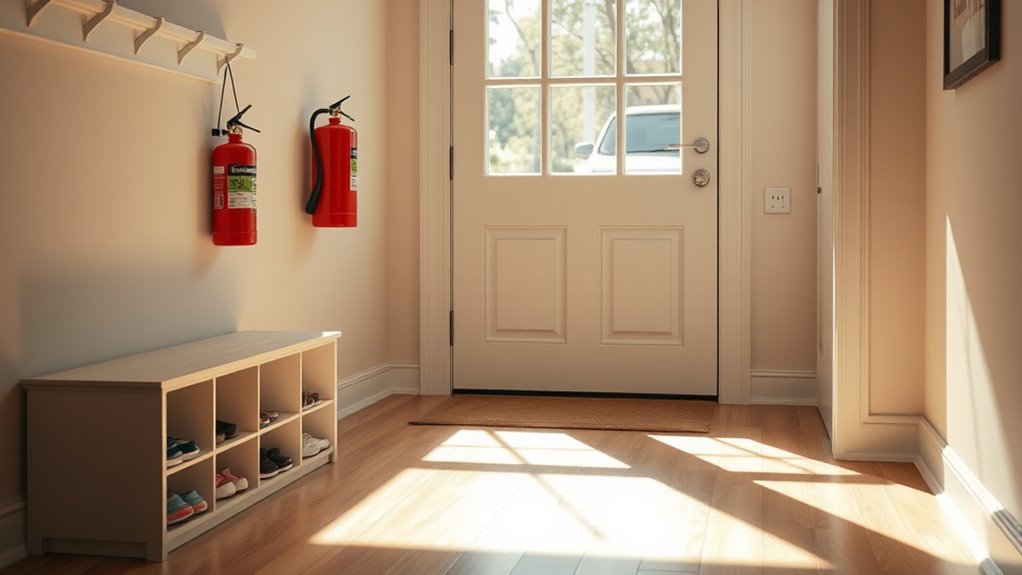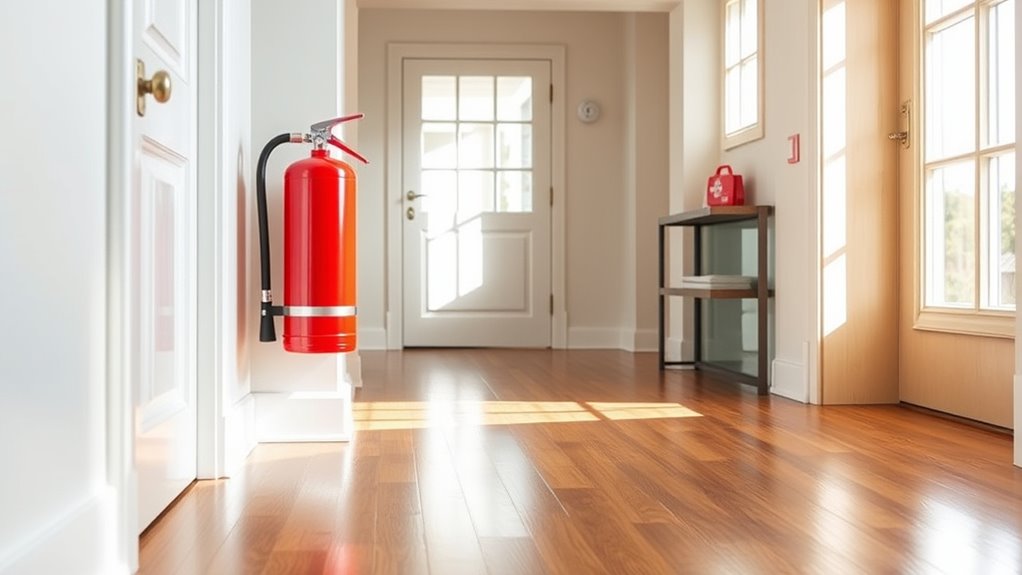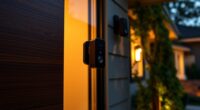Spending just 10 seconds regularly practicing your fire escape routes or inspecting your smoke alarms can markedly boost your home’s safety. By mentally reviewing exits or ensuring alarms work properly, you build confidence and responsiveness during emergencies. These simple habits reinforce preparedness, making it easier to act swiftly if needed. Keep consistency in these quick checks, and you’ll create a safer environment effortlessly. Stay tuned to discover even more quick strategies to protect your home and loved ones.
Key Takeaways
- Regularly review and mentally rehearse your home’s emergency escape routes for quick recall.
- Conduct quick fire alarm tests monthly to ensure alarms are functioning properly.
- Keep escape pathways clear and accessible for rapid evacuation.
- Check fire alarm batteries and replace immediately if alarms beep or are silent.
- Involve all household members in the 10-second safety routine to strengthen emergency preparedness.

Have you ever wondered how just 10 seconds can make your home considerably safer? It’s a small window of time, but when used wisely, it can markedly improve your safety. The key is developing a simple but effective habit: taking 10 seconds to check your fire alarm and review your emergency escape routes. This quick routine can be the difference between chaos and control during an emergency.
Start by making it a regular part of your schedule to inspect your fire alarm. You don’t need to do a full maintenance check—that’s best left to professionals—but a quick glance can ensure the alarm is visible, unobstructed, and functioning properly. Many fire alarms have test buttons designed for this purpose, and pressing them for a second or two will confirm the device’s battery life and operational status. If your alarm is silent or beeping, don’t ignore it; replace batteries immediately or replace the unit if necessary. Consistent fire alarm maintenance isn’t just about compliance; it’s about ensuring you’ll be alerted in time if smoke or fire appears. When your alarms are working correctly, you gain peace of mind, knowing you’ll be warned early enough to act.
Regularly test your fire alarms and replace batteries promptly to stay safe and alert.
Alongside checking your fire alarms, take a moment to review your emergency escape routes. Know at least two ways out of every room, ideally leading to a safe outdoor location. This quick mental review helps reinforce your familiarity with the routes, especially in the dark or if visibility is compromised. Make sure pathways are clear of clutter, and check that windows and doors can be opened easily. If you have young children or elderly family members, ensure everyone knows and remembers these escape plans. Regularly practicing your escape routes, even for 10 seconds at a time, keeps them fresh in your mind and reduces hesitation during a real emergency. This habit ensures you won’t waste precious seconds figuring out how to get out when seconds truly count.
Incorporating these quick safety checks into your daily routine might seem insignificant, but they build a foundation of preparedness. Fire alarm maintenance should be a priority, and reviewing your escape routes keeps everyone in your home ready to respond. Those 10 seconds are enough to confirm your alarms are working and your escape plan is solid. Over time, this simple habit becomes second nature, turning a brief daily check into a powerful tool for safety. Remember, safety isn’t about grand gestures; it’s about small, consistent actions that protect you and your loved ones every day. Additionally, understanding home safety essentials can further strengthen your preparedness and peace of mind.
Frequently Asked Questions
How Often Should I Perform This 10-Second Safety Check?
You should perform this safety check daily to guarantee your home stays safe. Following the frequency guidelines, making it part of your safety check schedule helps catch hazards early. Incorporate this quick 10-second habit into your morning or evening routine, so it becomes automatic. Regular checks keep you aware of potential dangers, giving you peace of mind and maintaining a secure environment for everyone in your home.
Can This Habit Prevent All Types of Household Accidents?
Can a quick safety check prevent all household accidents? While it substantially reduces risks like fire hazards and electrical safety issues, it can’t cover every situation. This habit is a powerful step toward a safer home, but you should also stay vigilant, maintain proper safety measures, and address specific hazards. Combining regular checks with proactive safety practices offers the best chance to prevent most accidents.
Is This Habit Suitable for Children to Do Alone?
No, children shouldn’t do this habit alone. Child supervision is essential, as safety education teaches them about potential hazards. You need to guide your kids through this habit, ensuring they understand its importance and risks. By supervising, you help foster safe behaviors and prevent accidents. It’s a vital step in keeping your home safe, especially for young children still learning about safety, so never let them do it unsupervised.
What Tools or Items Are Needed for This Habit?
They say “Better safe than sorry,” so gather a safety checklist and an emergency kit. You’ll need a flashlight, batteries, a first-aid kit, and a whistle. Consider adding a pen and paper for notes. Keep these items accessible, so you can quickly verify safety measures or respond in emergencies. Regularly check your safety checklist and replace supplies in your emergency kit to stay prepared.
How Quickly Can I See Safety Improvements After Starting?
You can see safety improvements almost immediately after starting by using visual reminders and conducting regular safety audits. These simple steps help you identify hazards quickly and reinforce safety habits daily. As you place visual cues and review your home’s safety conditions, you’ll notice fewer accidents and a more secure environment within days. Consistent practice keeps safety top of mind, making your home safer faster.
Conclusion
Making this simple 10-second habit part of your routine is like adding a sturdy lock to your door—small, quick, but incredibly effective. It’s the tiny step that shields your home and loved ones from unforeseen dangers, turning your house into a fortress of safety. Just a quick check can prevent big problems down the road. So, embrace this habit daily; it’s the key to turning your home into a safe haven you can always rely on.









